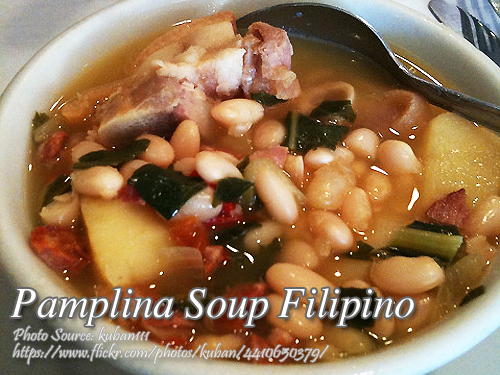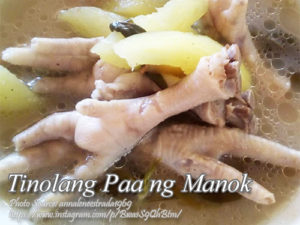Pamplina is a Spanish soup dish composed of meats such as ox feet, salt pork, chorizo de bilbao and vegetables like potatoes, cabbage, white beans, olives and of course onion and garlic. If you are not familiar with salt pork as I am, it is a salt-cured pork and usually prepared from one of three primal cuts: pork side, pork belly, or fatback. Unlike bacon, salt pork is not smoked, but rather is cured by being packed with salt.
Pamplina Soup Filipino: A Hearty Taste of Tradition
There are some dishes that have a way of bringing back memories, ones that transport you to a time when life was simpler, and meals were meant to be savored with family gathered around the table. Pamplina is one of those dishes for me. My lola, Aling Rosa, used to make this rich and hearty soup whenever the rainy season arrived in our small town in Batangas. She would wake up early, as she always did, setting a large pot on the stove and letting the comforting aroma of garlic and chorizo fill the house before anyone even got out of bed.
A Spanish Influence in Filipino Cooking
Pamplina is a dish that traces its roots to Spanish cuisine, a culinary influence that remains strong in many Filipino recipes. This hearty soup is a wonderful example of how Spanish flavors merged seamlessly with local ingredients, creating something uniquely Filipino. It’s made with an assortment of meats like ox feet, salt pork, and chorizo de Bilbao, combined with potatoes, cabbage, white beans, and briny olives. Each spoonful carries a richness that makes it the perfect comfort food, especially on a cold, drizzly afternoon.
The Secret to the Best Pamplina
One of the most important steps in making a truly flavorful Pamplina is the slow simmering of the beef pata. My uncle, Mang Ernesto, always said, “Patience is the key, hija. Let the meat cook low and slow.” And he was right. Simmering the ox feet for hours allows the tendons to break down, releasing a gelatinous texture that thickens the broth naturally and gives it a mouthwatering depth of flavor.
Another trick that my cousin Linda swears by is using salt pork. If you’ve never cooked with it before, think of it as bacon’s saltier cousin. Unlike bacon, it’s not smoked, but it has an intense savoriness that infuses the broth with a rich umami taste. This ingredient, combined with the deep, smoky essence of chorizo de Bilbao, makes Pamplina a dish that is truly unforgettable.
Building the Flavors Step by Step
Once the beef pata is tender, the next step is bringing all the ingredients together. First, the salt pork is boiled and cut into cubes, releasing its salty goodness into the soup. Meanwhile, white beans are simmered until soft, adding another layer of texture. In a separate pan, garlic and onions are sautéed in olive oil, filling the kitchen with their familiar, homey scent. Then comes the chorizo and potatoes, both of which soak up the oil and become deeply flavorful as they cook.
The broth from the pata is added next, absorbing all the richness from the bones and the simmered meat. The diced ox feet and salt pork go into the pot, followed by the tender cabbage, which softens just enough to complement the heartiness of the soup. Everything is left to simmer until the broth thickens, allowing the flavors to meld into one another. A final touch of salt and pepper, and just like that, you have a bowl of pure comfort ready to be served.
A Soup Worth Sharing
Whenever my brother Tito visits from abroad, this is the dish he always asks for. “Walang tatalo sa lutong bahay,” he says every time, dipping a piece of crusty bread into the thick broth, savoring every bite. And he’s right. There’s something about Pamplina that feels like home. Maybe it’s the way the flavors develop slowly over time, just like the best family traditions, or maybe it’s the way each ingredient plays a role in creating something greater than the sum of its parts.
For beginner cooks, this dish may seem a bit intimidating at first, but trust me—it’s worth the effort. The key is to take your time, let the ingredients do their magic, and most importantly, cook it with love. That’s what makes Pamplina special. It’s not just a soup; it’s a dish steeped in history, passed down from generation to generation, a reminder that the best meals are always the ones shared with family.
A Taste of the Past, A Dish for the Future
Pamplina is more than just another soup; it’s a testament to our rich culinary heritage. It’s a dish that tells a story of how Filipino cuisine has evolved, borrowing influences while still remaining distinctly ours. So the next time you’re craving something warm, comforting, and deeply satisfying, give this recipe a try. You might just find yourself falling in love with its flavors, just as my family has for generations.
How to Cook Pamplina
Ingredients
- 1 1/2 kilo beef pata
- 1/4 kilo salt pork
- 1/4 cup olive oil
- 4 large onions chopped
- 1 head garlic crushed
- 3 pcs Chorizo de Bilbao sliced
- 4 pieces potato cubed
- 1 cabbage cut into strips
- 1 bay leaf
- 1/4 kilo white beans soaked overnight
Instructions
How to cook Pamplina Soup
- Clean beef pata and put in a pot with the bay leaf. Simmer till tender, about 4 hours.
- Remove skin and tendons from bones and cube. Set aside the broth.
- Boil salt pork and cube. Put beans in a pot, with water to cover. Simmer till tender, about 2 hours.
- Heat olive oil in a casserole. Saute garlic, onions, chorizo and potatoes. Add broth from the pata.
- Add pata, salt pork, cabbage. Simmer till the soup thickens. Season with salt and pepper.
Notes
Cooking Tips:
Slow Simmer for Maximum Flavor
The key to a rich and deeply flavorful Pamplina is slow simmering the beef pata until it becomes fall-off-the-bone tender. This process allows the natural collagen to break down, giving the broth a thick, velvety texture. Rushing this step will result in a thinner, less flavorful soup, so patience is essential.Enhance Taste with Salt Pork and Chorizo
Salt pork adds a deliciously savory depth to the soup, while chorizo de Bilbao infuses it with a smoky, slightly spicy kick. Be sure to render the fat from these meats by sautéing them first, allowing their flavors to meld into the broth. This technique enhances the overall taste, making each spoonful more satisfying.Let the Ingredients Marry Together
Pamplina tastes even better when given time to rest, as the flavors continue to develop after cooking. If possible, let the soup sit for a few hours or even overnight before serving. This allows the broth to absorb all the seasonings, resulting in a more cohesive and delicious dish.






Yummy!, kaso medyo magastos itong recipe but, mukhang masarap naman. 🙂